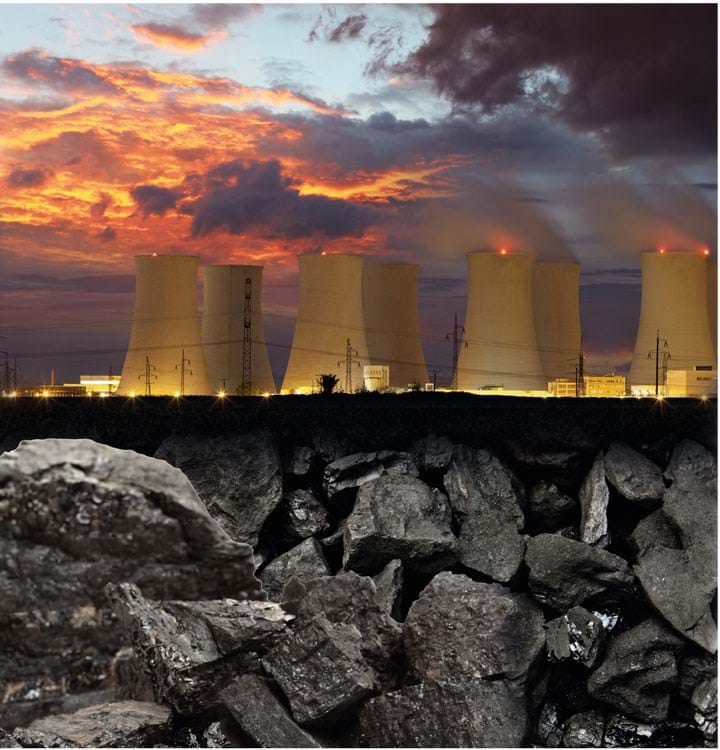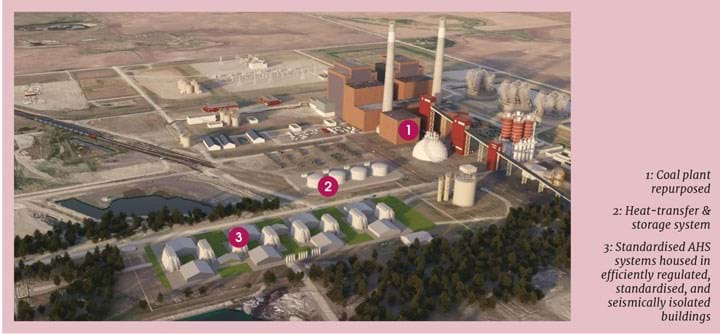Energy: Coal to Nuclear


Amanda Doyle speaks to Adrian La Porta about replacing coal-fired boilers with nuclear reactors
Coal accounts for 40% of CO2 emissions from energy combustion and industrial processes, and air pollution from coal-fired power plants is linked to numerous health issues. Yet shutting down coal-fired power plants has its own set of challenges, such as the impact of job losses on the local economy, as well as financial losses due to plants becoming stranded assets.
I spoke to Adrian La Porta, Technical Director of Process Engineering at design company Bryden Wood, about work that the company is contributing to which aims to develop a standardised approach to replacing coal-fired boilers with nuclear reactors in a way that is cost effective and keeps most of the existing infrastructure.
Using next-generation nuclear reactors
Bryden Wood is part of a group of companies working on the Repowering Coal project led by TerraPraxis, along with MIT, the University of Buffalo, Microsoft, and KPMG. “The principle is that we’re designing a system that would allow multiple different technology providers of different advanced modular reactors (AMRs) to use the same building system,” says La Porta. “The key point is that they are modular so the reactors themselves are almost entirely built off site and transported to sites. In principle, it could also be used with fusion reactors in the future, a bit further out obviously.”
AMRs are next-generation reactors that can have advantages such as being more efficient or improved waste management. The first AMRs are expected to be ready by 2028, at which point the group expects their approach to be ready.
Coal accounts for 40% of CO2 emissions from energy combustion and industrial processes

Project execution
Ordinarily, building a new nuclear facility is extremely costly and poses risks to investors. La Porta said that this is as much a project execution and market development problem as a technical problem, with a lot of cost associated with project execution.
“We’re developing tools which would allow, for instance, an investor or a coal plant owner to very quickly assess a site or a fleet of coal-fired power stations and to assess their suitability for deployment of AMRs on their sites.” He said that feasibility studies that would typically cost tens of millions of dollars and take up to ten months can be done in days at a much lower cost with the new tools.
“Those kind of design automation and assessment tools are one of the components of this technology platform that we’re aiming to use to unlock the deployment of nuclear power to replace coal-fired boilers.”
Decoupling the reactor from the power station
La Porta also described the technical challenges faced by the group. “One of the challenges that we’re trying to address is the requirement to have multiple different reactor types across multiple different coal fired power stations, each with their own site constraints, their own seismic requirements, their own grid connections. We’re trying to avoid having to do a completely bespoke design for every possible combination of those things.”
The University of Buffalo has developed seismic isolation systems so that buildings and reactors no longer need be designed specifically to site conditions.
MIT has developed a heat storage and transfer system based on the use of molten salt coolants so that the nuclear reactor is decoupled from the rest of the power station. The reactor generates heat which enters the heat transfer system, and this system then raises the steam that drives the turbine. The system acts like an adaptor, meaning that the turbine and generator don’t have to be designed to nuclear standards and that the existing equipment in the coal-fired plant can still be used. Reusing a significant proportion of the existing facilities reduces the cost by around 40%.
Waste heat from reactors can also potentially be used to provide high grade heat for process applications.

Switching to nuclear reactors would provide a benefit to communities as the power plants remain operational
The importance of standardisation
The proposed solution relies on standardisation of project execution and technology, which comes with many benefits. Reactor manufacturers can focus purely on the reactors without getting involved in the complexities of site-specific solutions. Components that previously had to be designed to be nuclear rated – such as pumps or compressors – no longer need to be nuclear rated due to the decoupling of the reactor. This will expand the supply chain to the general engineering and construction industry rather than relying on a few highly specialist nuclear companies.
Standardisation will also make it easier for projects to gain regulatory approval, as well as manage process safety concerns through the use of modularisation. It also reduces the uncertainties for investors.
Social and economic benefits
Switching to nuclear reactors would provide a benefit to communities as the power plants remain operational, and the group has factored in retraining operators. Communities near coal plants also have increased health risks due to the particulate matter from the plant, and this is no longer an issue with nuclear reactors.
Currently, coal-fired capacity is at around 2 TWe globally, with a lot of plants less than 15 years old, increasing the likelihood for resistance to closures. “It’s really critical that there is a solution that’s very much tailored to what to do with coal-fired power stations,” said La Porta. “We think this is a more targeted solution than suggesting that they should all be shut down and replaced by different power sources in different locations.”
Recent Editions
Catch up on the latest news, views and jobs from The Chemical Engineer. Below are the four latest issues. View a wider selection of the archive from within the Magazine section of this site.




